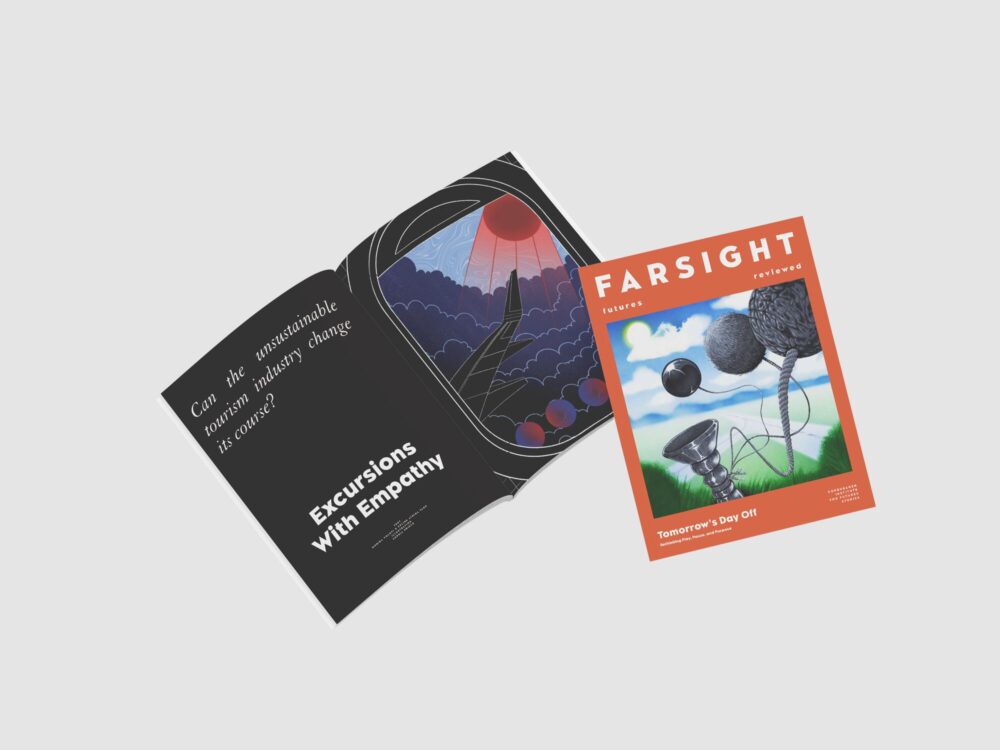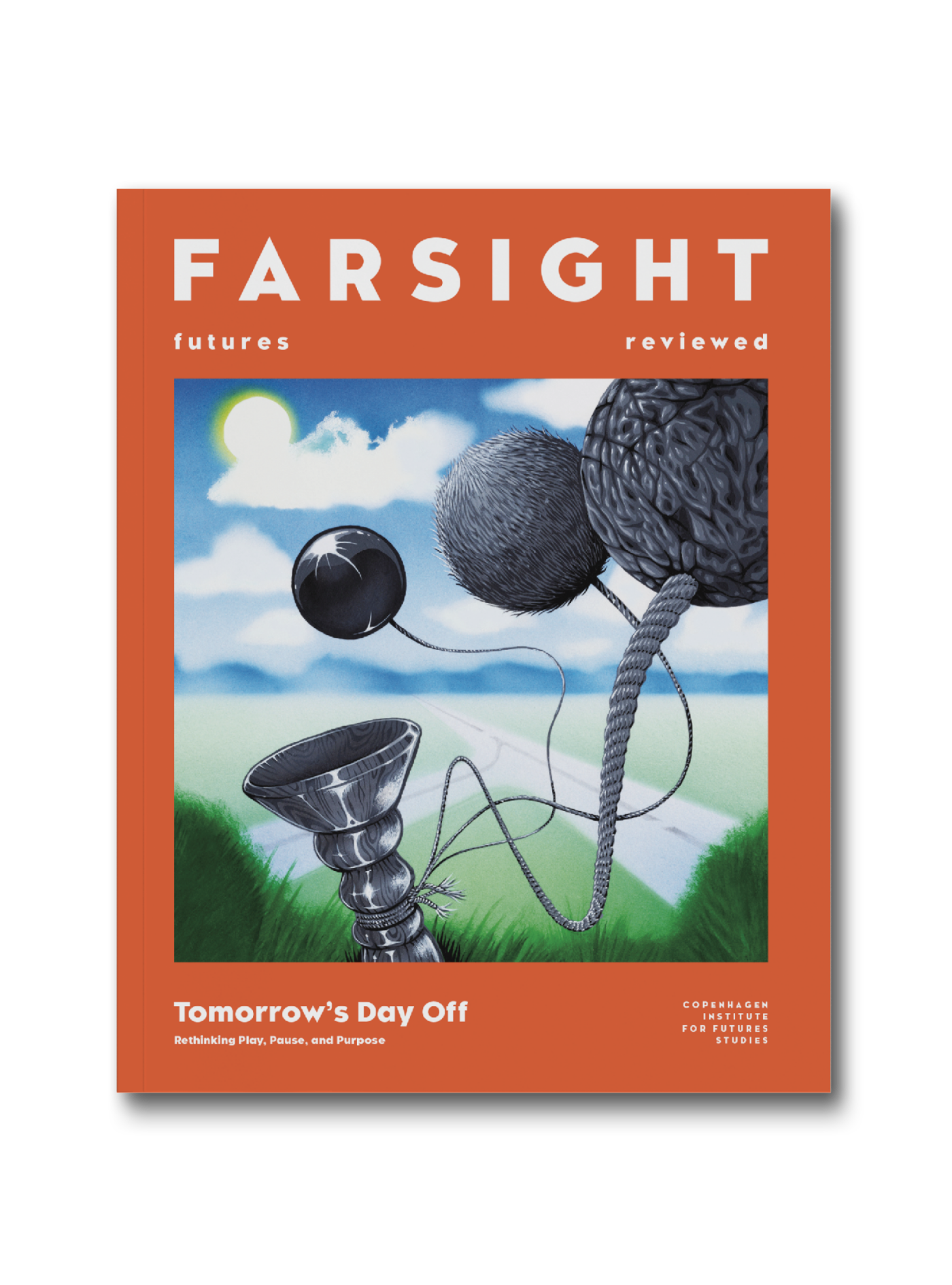
In turn, we use cookies to measure and obtain statistical data about the navigation of the users. You can configure and accept the use of the cookies, and modify your consent options, at any time.

Eating & Techno-Pleasures
How might new culinary experiences be aroused?
Image: Midjourney AI
Imagine an idyllic sunset, a candlelit meal that summons intensive eye contact, and faint aromas of fresh herbs floating through the air. You savour each mouthful of spaghetti alle vongole, sucking and swallowing as the taste lingers on your lips stained with red wine. Across the table, you playfully express to your forbidden fruit that they look good enough to eat. It’s not a difficult nor an unpleasant scenario to imagine.
Both food and sex arouse our senses, feed our indulgences, and keep human existence going. The two so naturally find one another that once you start to look, you can find their physical and metaphorical intertwinement everywhere. From pop culture to product marketing, whether it’s a provocative scene of Timothée Chalamet engaging intimately with a peach or fast food chains exploiting the allure of women’s bodies to sell hot wings, food and sex arguably awaken our senses in similar ways.

Broaden your horizons with a Futures Membership. Stay updated on key trends and developments through receiving quarterly issues of FARSIGHT, live Futures Seminars with futurists, training, and discounts on our courses.
become a futures memberAt the core of both are the textures, tastes, sights, and smells which so intimately connects us to them. This connection can be traced back through much of human history. The ancient Greeks associated their goddess of love and beauty, Aphrodite, with libido-heightening foods. Her culinary symbol of a pomegranate represented both fertility and first-time sexual experiences, referencing the stains from the rich red seeds and juices. Beyond this, food and sex are closely related in terms of their biological functions, with both releasing dopamine and activating the same ‘rest and digest’ parasympathetic nervous system that is integral to our survival. It is unsurprising that the two stir up such similar feelings of desire – or even at times disgust.
Although eating and sex are arguably our most basic pleasures, their primordial nature does not leave them untouched from the lure of the future. In fact, it is technology’s convergence with these pleasures which could push eating and sex into a rather whimsical and uncharted territory.
Although using tools to amplify or automate carnal pleasures is a tale as old as Homo Sapiens, technology’s historical relationship to sex and food may not seem directly comparable at first. Finding innovative ways to accentuate pleasure has always been the case for sex: one of the world’s oldest archaeological findings is, after all, the dildo. Technology’s relationship to food has been seemingly more concerned with productivity, efficiency, and quantity. This is understandable; we can live without the gratification of sex (regardless of lingering desires) but would perish without food. The history of stimulating pleasure via technology beginning with sex rather than food is therefore not a surprise.
This development started accelerating at the end of the 19th century with the first erotic film. Sexual pleasure could now be documented not only visually, such as through drawings or photographs, but with movement and time as well. During this period, pleasure took on different dimensions within the food industry as well. As abundancy increased, concentrates artificially added to foods and flavour enhancers made our dinners moreish beyond their natural capacity.
Crucial to the technologisation of pleasure are the attempts at recreating it in its most realistic form. Our current digital age represents this drive most obviously, with hyper-realistic pornography holding the throne of internet browsing history – over 2.5 million people visit popular porn sites every 60 seconds – while #foodporn yields nearly 300 million Instagram posts. It is safe to say many have been getting off on these simulations of pleasurable content – albeit in different ways.
However, assumptions that technological developments will only lead to the imitation of pleasure in its most life-like form, whether that be the human touch or the smell of coffee brewing, should be approached with caution. What’s perhaps more intriguing is the possibility of moving away from true to life technological attempts at simulating and recreating pleasure and towards a pursuit of creating radically new pleasures. Could novel developments in the SexTech industry provide a glimpse into the emerging and wild ways we might eat in the future?
Drawing on perhaps the most controversial example of all, sex robots tend to take a prominent role in imaginations of how our most basic desires may be satisfied in new ways. Yet if Masahiro Mori’s theory of the Uncanny Valley holds true, perhaps these robots are doomed from the get-go as feelings of unease and even disgust could be evoked in many of us in response to highly realistic humanoids.
In her extensive work on sex robots, computer scientist Dr. Kate Devlin finds that the kind of hyper-realistic fembots that dominate our collective imagination of the future of technological sex will only make up a small and niche market. It is instead more likely, she believes, that we will see a move into abstraction and away from objectification.
By this Devlin means that we will see an emphasis on features that derive the most amount of pleasure, for example through smart fabrics, conductive paint, soft robotics and sensors, and materials which can respond to touch and touch us back. Popular and widely used devices such as vibrators, which are increasingly becoming softer and more abstract, are neither human-like nor gendered. Replicating how we achieve pleasure in its most ‘life-like’ form is perhaps neither the easiest thing to do, nor something many of us want, as it often relies on complex human connections with texture, taste, and smell, and often, with other people.

Explore the world of tomorrow with handpicked articles by signing up to our monthly newsletter.
sign up hereInstead of chasing realism in all aspects, technology may instead enable us to reimagine the ways we can derive pleasure. The nascently developing world of ‘food simulation’ is following a similar path – away from attempts at imitating the real world and towards enhancing our sensory experience in new ways. Both scientists and artists are taking steps to explore technology’s potential to unsettle definitions of what it means to eat.
On the more experimental side, initiatives like Project Nourished, founded by designer and technologist Jinsoo An, use technology to redefine the eating and drinking experience. The initiative, which aims at optimising the functional aspects of food while minimising the environmental impacts, has so far succeeded in creating a ‘food-sensing plate’ and embedded fork for mixed-reality dining, a utensil that enables eating without swallowing, a food-grade diffuser with multiple chambers, and the analysis of the computational form of edible objects.
Eventually, Project Nourished aims to lead the way towards even more eccentric culinary futures by enhancing human sensory experiences through brain-interfacing tools and software. By mutating ingrained definitions, our common understanding of food as something that needs to be swallowed, digested, and nutritional is being questioned. In fact, the creators of Project Nourished go so far as to deem ‘food’ a term that is unsuitable for the future, considering the word ‘consumable’ – defined as an object which simply triggers one or more biological activity such as chewing or inhaling – more appropriate.
Notably (and perhaps terrifyingly), this hints at a potential future where technology has the capacity to obscure the answers to even the simplest of questions. Does food need to be digested to be considered food? Is chewing gum a food, despite it being chewed with the intention of experiencing pleasure from the smell, taste, and consistency without swallowing? Or does food have to have nutritional value to be considered food? Should dietary supplements in the form of pills then be considered food since they provide a form of nutrients, are swallowed, and digested by our bodies? In fact, food and sex can become more linked when technology transforms their meanings. If we accept this re-definition of ‘consumable’, does smelling another’s cheek, swallowing their saliva and absorbing their sweat equate to ‘consumable sex’? The introduction of technology has not only the potential to transform taken-for-granted behaviours, but for this to be enabled also outside of the digital world.
The technologically-derived pleasures in eating and sex may increasingly overlap as haptic feedback technology gains popularity. This technology has been driven by innovation in the sex industry to allow humans to send and receive touch from a distance, and thus it attempts to simulate sex artificially. Haptic feedback arouses human senses by issuing feelings of vibrations, pulses, and pressure, it allows users to feel touches and textures. But this also means that haptic feedback, coupled with experimental technologies as found in Project Nourished, provides a big playground when considering how technology does not simply simulate, but rather transforms our affinity with food. No one will want to eat virtual spaghetti alle vongole in VR, and your partner probably won’t find your avatar sexy. But could we instead experiment in digital worlds with enhancing and altering human sensory experience, allowing us to smell agave, taste lychee, and feel fur from what looks like something found off the pavement?
Whether one agrees with these radical attempts at redefinition or not, it’s clear that the introduction of technology has the potential to both provoke new meanings and transform primal pleasures. Through the digital, new and different ways of relating with our most core pleasures can be imagined. A home-cooked meal made with care and sex with human intimacy may be the most pleasurable, and also the most sought after by many. But co-existing alongside ‘real-world’ pleasures, new technologies will continue to push the boundaries of sensual gratification. Whether that’s through smart fabrics that touch us, experimenting with ‘consumables’, or even the two combined, social attitudes about sex, food, and pleasure can be altered through technological manipulation, and in possibly quite a wonderful way.

Read the latest issue of
FARSIGHT:
Tomorrow’s Day Off
Grab a copy here